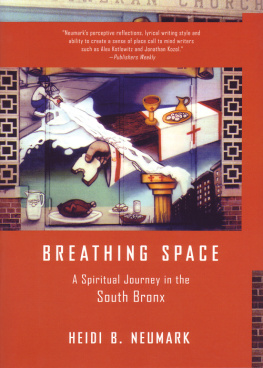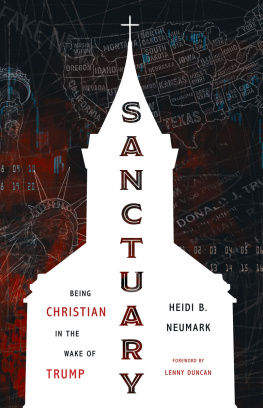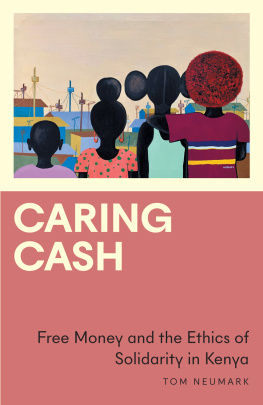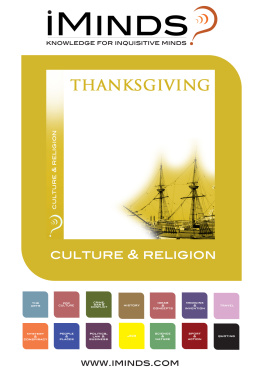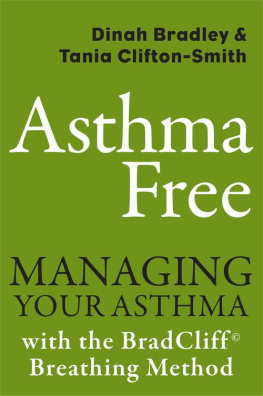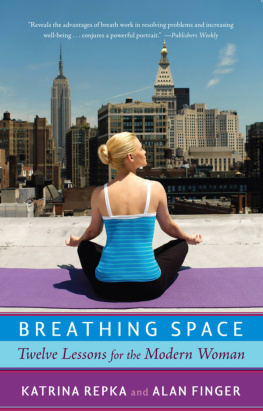To Gregorio
Perdona mi amor
por tanto hablar,
es que quiero ayudar
al mundo cambiar.
!Qu loca!
y a los queridos santos de
Transfiguracin con muchsimo amor
And to the beloved people of
Transfiguration who have transfigured me
El Tiempo es Veloz, David Lebn
Have mercy on your people, Lord, and give us
a breathing space in the midst of so many troubles.
MISSAL OF PIUS V
PREFACE
Break forth together into singing you ruins of Jerusalem.
Isaiah 52:9
The stone that the builders rejected has become the chief cornerstone.
Psalm 118:2
This book began in the spring ruins of Oklahoma City in 1995 and reached completion seven years later in the aftermath of the September 11 attack on the World Trade Center. At the time of the first bombing, I was experiencing some weariness after a decade of pastoral work in the South Bronx, and found myself in serious need of breathing space. Watching the televised grief of people in a distant city was like looking into a mirror and seeing what I hadnt wanted to see. I needed to grieve. I thought of the Bronx mother who raced to get a basin of water to scrub her murdered sons blood off the street before the cars and buses could desecrate what to her was holy. She went out alone and held off the cars until she was finished. I needed to stop the busy traffic that barrels through each day, stand vigil, pause, and remember. Grieving was a way for me to say that this blood mattered, the blood that had flooded my heart.
In the early eighties, I joined with people whod been working long and hard before I was ever called here, dedicated agents of transfiguration amidst the rubble. At that point, the South Bronx had gained international infamy as the ground zero of urban blight. More often than not, I was the witness of deep faith and inspiration, heroism and indefatigable dignity, but other realities were taking their toll: AIDS, crack, heroin, methadone, cutbacks, kickbacks, corruption in virtually every corner of the boroughs infrastructure, never enough time, never enough money, never a night without gunfire, or a week without funerals.
Just as our son Hans, then eleven, wanted us to turn off the news in the wake of September 11 and return to more cheerful activities, I wanted to turn my attention from the pain and focus on the uplifting moments. One of the reasons I avoided giving voice to my own grief was out of respect for the other grievers. There is an idolatry of lurid, inner city imagesa colleague calls it urban pornography, slick one-dimensional takes that titillate but invite no true relationship. There is a certain fascination with objectified extremities of the urban scene, safe to gawk at on an airbrushed screen or page, but far too threatening to engage in any meaningful, life-changing way. Ive never wanted to foster this and feed into the stereotypes that bring tourists with cameras looking for the rumble and the rubble.
I am drawn to a different visionthe walls rebuilt, the land reclaimed, the people who rise up like grass improbably breaking through slabs of stone. But the losses took their toll. To stand here is also to stand in the center of so much that is wounded and wrong in this nation and world, in a well of catastrophe that is, at the same time, a center from which springs amazing grace. I was busy like a politician putting the right spin on things, not just for others, but for myselfthe grace spin, but I didnt need to do that. The denial of loss and difficult truths are not the attendants of grace. I have learned that grace cleaves to the depths, attends the losses and there slowly works her defiant transfiguration.
At the end of the summer before September 11, I cleaned out old toys and games with Hans. Together we sorted the wooden blocks, the Legos and KNex. At one point, when Hans wasnt looking and I was tired of sorting, I dumped a bunch of mixed-up pieces in the garbage. There seemed to be an ample supply of building materials that remained. I almost took the boxes to my mothers attic, thinking that sixth grade would bring other interests and entertainments. Now I thank God that the boxes never left home. This is one time when procrastination paid off.
Soon after watching the televised images of the Towers collapse, Hans reached for the wooden blocks hed been building with since before he could walk. As we sat mute and motionless before the news, Hans reenacted it. Block upon block went up in one tall tower and then another. After that, he found an old model airplane and knocked them down. Just leave it there, Hans told us, and later, he put it all away. A few days after this reenactment, Hans got out the KNex and began a building program that lasted for months. The first thing he built was a replica of the Empire State building, strikingly accurate and almost as tall as he was. New creations were added daily. Some were taken apart and rebuilt, although the Empire State Building continued to tower over the rest. In the beginning, Hans gave us daily advisories with his building plans. We lived in a construction zone and had to negotiate an increasingly intricate display of structures to get from room to room.
There was something almost compulsive about Hanss need to build and in his daily efforts, which he had to fit between homework, meals, and other frustrating interruptions, I saw my own need and struggle to write. When more things seemed to be falling apart than coming together, I reached for words as Hans reached for the KNex. But it was easier for Hans to find the right KNex to fit his architectural designs. For the longest time, I was just lifting up pieces without knowing where to place them.
What shall I preach? All flesh is grass... the grass withers, the flower fades.
Isaiah 40:6ff.
The prophet Isaiah, that ancient correspondent from the sixth century B.C.E. is a good companion in the wake of urban ruin. The mighty army of the Babylonian Empire had ripped though the inner city of Jerusalem, destroying homes, businesses, and the temple itself. The hallowed site of a peoples history, tradition and pride became a place of disaster and corruption. When Isaiah looked around, he saw a traumatized community taken captive and deported to Babylon, the smoking ruins of the city still blurring their vision, and choking their souls.
Isaiah was one of them and their questions were his own: What shall I preach? All flesh is grass... the grass withers, the flower fades. (Isaiah 40:6ff.) What was there to say? What difference could it make? And yet, the story cried out to be told. Deep sadness seems to swallow up language and simultaneously compel speech. Reflecting on the transiency of life after the fall of Jerusalem, Isaiah bewailed his loss of words but then went on to write some of the most passionate and eloquent poetry in the Hebrew scriptures.
The sacred stones lie scattered at the head of every street, sighed Isaiahs prophetic contemporary in lamentation, Jeremiah ... the precious children worth their weight in goIdhow they are reckoned as earthen pots... For these things I weep; my eyes flow with tears; my children are desolate. (Lamentations 4:1-2, 2:16) The prophet could have been describing the devastation wrought on September 11 here in New York City. And the prophet could have been describing the inheritance of the children who played among skeletal remains of burnt-out buildings that covered 300 acres of vacant land in the South Bronx in the seventies and early eighties.

